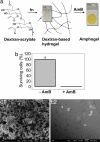Antifungal hydrogels
- PMID: 17664427
- PMCID: PMC1941801
- DOI: 10.1073/pnas.0705250104
Antifungal hydrogels
Abstract
Fungi are increasingly identified as major pathogens in bloodstream infections, often involving indwelling devices. Materials with antifungal properties may provide an important deterrent to these infections. Here we describe amphogel, a dextran-based hydrogel into which amphotericin B is adsorbed. Amphogel kills fungi within 2 h of contact and can be reused for at least 53 days without losing its effectiveness against Candida albicans. The antifungal material is biocompatible in vivo and does not cause hemolysis in human blood. Amphogel inoculated with C. albicans and implanted in mice prevents fungal infection. Amphogel also mitigates fungal biofilm formation. An antifungal matrix with these properties could be used to coat a variety of medical devices such as catheters as well as industrial surfaces.
Conflict of interest statement
The authors declare no conflict of interest.
Figures




Similar articles
-
Levan-based hydrogels for controlled release of Amphotericin B for dermal local antifungal therapy of Candidiasis.Eur J Pharm Sci. 2020 Mar 30;145:105255. doi: 10.1016/j.ejps.2020.105255. Epub 2020 Feb 4. Eur J Pharm Sci. 2020. PMID: 32032777
-
Co-delivery of antiviral and antifungal therapeutics for the treatment of sexually transmitted infections using a moldable, supramolecular hydrogel.Adv Healthc Mater. 2015 Feb 18;4(3):385-94. doi: 10.1002/adhm.201400340. Epub 2014 Sep 18. Adv Healthc Mater. 2015. PMID: 25234003
-
Antifungal catheter lock therapy for the management of a persistent Candida albicans bloodstream infection in an adult receiving hemodialysis.Pharmacotherapy. 2014 Jul;34(7):e120-7. doi: 10.1002/phar.1433. Epub 2014 Apr 30. Pharmacotherapy. 2014. PMID: 24782326
-
Candida and candidaemia. Susceptibility and epidemiology.Dan Med J. 2013 Nov;60(11):B4698. Dan Med J. 2013. PMID: 24192246 Review.
-
Treatment of Candida famata bloodstream infections: case series and review of the literature.J Antimicrob Chemother. 2013 Feb;68(2):438-43. doi: 10.1093/jac/dks388. Epub 2012 Oct 19. J Antimicrob Chemother. 2013. PMID: 23085777 Review.
Cited by
-
The effect of biomaterials and antifungals on biofilm formation by Candida species: a review.Eur J Clin Microbiol Infect Dis. 2012 Oct;31(10):2513-27. doi: 10.1007/s10096-012-1634-6. Epub 2012 May 12. Eur J Clin Microbiol Infect Dis. 2012. PMID: 22581304 Review.
-
A Biodegradable Antifungal-Loaded Sol-Gel Coating for the Prevention and Local Treatment of Yeast Prosthetic-Joint Infections.Materials (Basel). 2020 Jul 15;13(14):3144. doi: 10.3390/ma13143144. Materials (Basel). 2020. PMID: 32679668 Free PMC article.
-
Bioinspired Hydrogels as Platforms for Life-Science Applications: Challenges and Opportunities.Polymers (Basel). 2022 Jun 11;14(12):2365. doi: 10.3390/polym14122365. Polymers (Basel). 2022. PMID: 35745941 Free PMC article. Review.
-
Candida Biofilms: Development, Architecture, and Resistance.Microbiol Spectr. 2015 Aug;3(4):10.1128/microbiolspec.MB-0020-2015. doi: 10.1128/microbiolspec.MB-0020-2015. Microbiol Spectr. 2015. PMID: 26350306 Free PMC article. Review.
-
Hydrogel-Based Active Substance Release Systems for Cosmetology and Dermatology Application: A Review.Pharmaceutics. 2020 Apr 26;12(5):396. doi: 10.3390/pharmaceutics12050396. Pharmaceutics. 2020. PMID: 32357389 Free PMC article. Review.
References
-
- Kuhn DM, Ghannoum MA. Curr Opin Invest Drugs. 2004;5:186–197. - PubMed
-
- Wisplinghoff H, Bischoff T, Tallent SM, Seifert H, Wenzel RP, Edmond MB. Clin Infect Dis. 2004;39:309–317. - PubMed
-
- Nguyen MH, Peacock JE, Jr, Tanner DC, Morris AJ, Nguyen ML, Snydman DR, Wagener MM, Yu VL. Arch Intern Med. 1995;155:2429–2435. - PubMed
-
- O'Toole G, Kaplan HB, Kolter R. Annu Rev Microbiol. 2000;54:49–79. - PubMed
-
- Douglas LJ. Trends Microbiol. 2003;11:30–36. - PubMed
Publication types
MeSH terms
Substances
Grants and funding
LinkOut - more resources
Full Text Sources
Other Literature Sources

